
PPJ Cruisers Ready to Leap
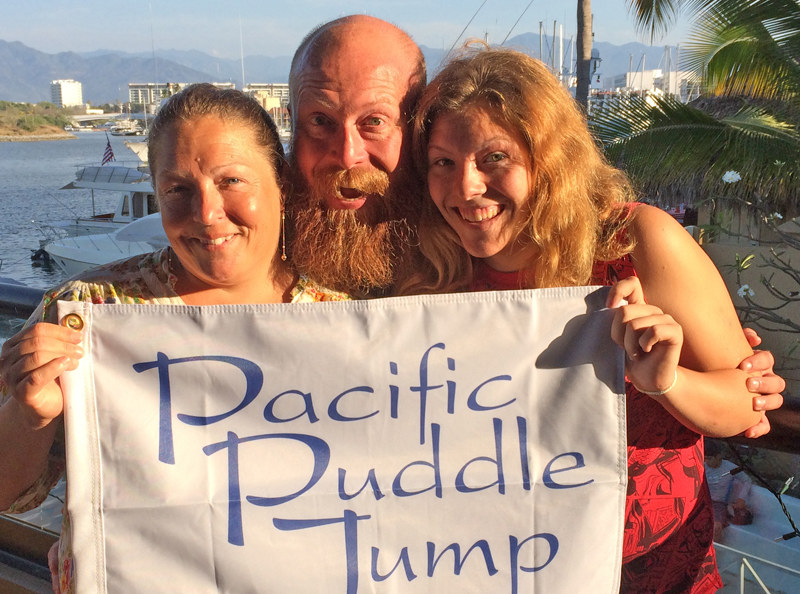
©2017Latitude 38 Media, LLC
In marinas and anchorages all along the West Coast of the Americas, cruising sailors from all walks of life are now preparing to make the 3,000- to 4,000-mile leap to French Polynesia and beyond — the ambitious passage we call the Pacific Puddle Jump.
This week, we’re having big fun getting to know many of them at our annual PPJ Sendoff Parties in Mexico (this past Monday at the Vallarta Yacht Club) and Panama (tomorrow at Balboa YC on the Pacific side of the Canal, then Saturday at Shelter Bay Marina on the Caribbean side).
As in years past, we’re discovering that the inspirations that drive these bold sailors to make the Jump are as varied as the boats they sail on and the size of their cruising kitties. In the April issue of Latitude 38 we’ll introduce you to the Jumpers we met this week in Mexico — from wide-eyed ‘twentysomethings’ to salty, gray-haired retirees. And in May we’ll profile the truly international mix of sailors who funnel through Panama on their way west.
As you’ll see in this video, shot Monday at Nuevo Vallarta’s Paradisve Village Resort, this year’s Mexico contingent is eager and excited as they make final preparations to head west.
Video Latitude / Andy
All in all, more than 160 boatloads of adventurers have registered (for free) so far this season, at the official PPJ website. So it’s safe to say that despite demographic shifts elsewhere, there’s no shortage of sailors eager to explore the dreamy isles of the South Pacific. Look for a complete recap of this year’s Puddle Jump crossing this summer in the pages of Latitude 38 magazine.
NOAA to Update Marine Charts
Ever wonder if your charts are old, outdated or missing new information?
The National Oceanic and Atmospheric Administration (NOAA) published a National Charting Plan last week outlining the agency’s efforts to modernize its entire catalog of nautical charts in the coming years.
The two-part plan details the current set of NOAA nautical charts as well as the Administration’s planned action to improve their charts and information. NOAA has already begun improvements on the data for wrecks in their electronic navigational charts. Other changes are still being considered, such as converting distances from fathoms and feet to meters.
After the Coast Guard decided to allow sailors to forgo carrying paper charts in February 2016, NOAA ramped up improvements to its electronic charts. The agency is also phasing out the production of new paper charts, as it now offers electronic charts, downloadable for free from the NOAA website. If you like the nostalgic feel of sea-proof paper charts, or simply want to carry them as an emergency backup, paper charts can still be purchased from NOAA-certified chart agents — we certainly think this is a wise idea.
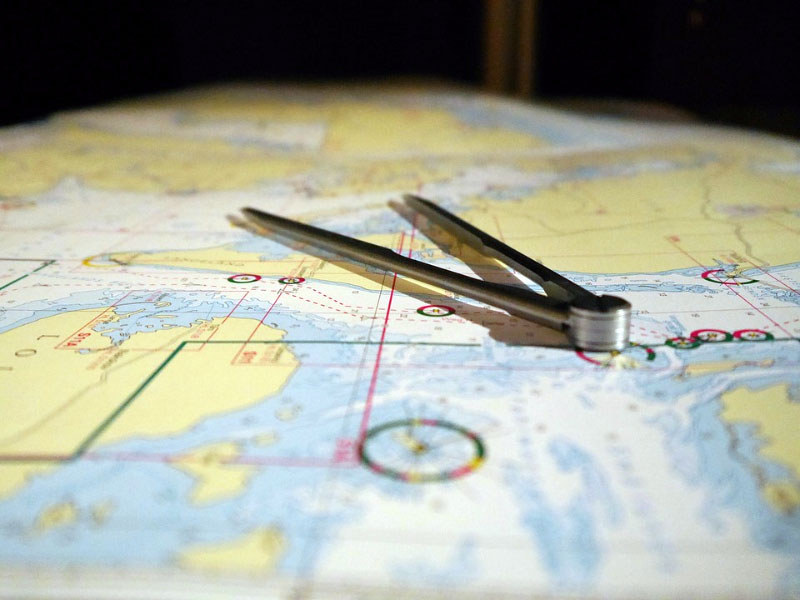
Rather than releasing new charts every two to 10 years, as was common practice with the paper models, NOAA will issue weekly updates to their electronic charts. If you’re worried about missing an important edit on your paper charts, NOAA publishes a comprehensive list of both critical and routine updates online here.
One important update that recreational boaters will notice in the coming year is the merging of individual electronic chart cells into a single database called the Nautical Information System. With current electronic charts, some parts of a larger chart do not match up properly, causing inconsistencies due to the different scale of each cell. The Nautical Information System will conform the various cells, making the entire chart more of a cohesive unit.
Although NOAA gives no timetable for the NIS plan, the agency expects to completely eliminate paper charts at some point as the use of their digital chart data increases.
As chart updates are phased in, NOAA welcomes feedback on the National Charting Plan from professional mariners, recreational boaters and those in the navigational equipment industry.
Have comments, raves or gripes about the new electronic chart updates or the elimination of paper charts? Let us know by emailing us.
Happy navigating!
Expect the Unexpected
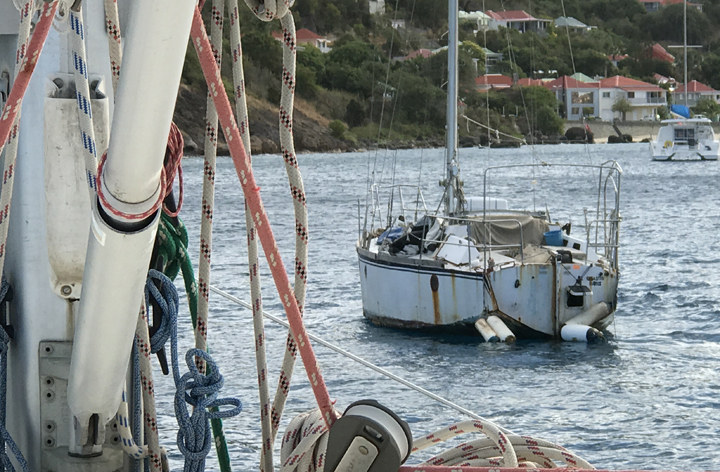
©2017Latitude 38 Media, LLC
Determined to live life to the fullest, last night the Wanderer and Doña de Mallorca battled the intermittent rain and 20- to 30-knot winds in St. Barth to make the one-mile-plus dinghy ride to shore for dinner and socializing in Gustavia. We felt confident that our catamaran ’ti Profligate would be all right, as we had her in perfect position in the lee of the big hill just to the north of Corossol, and she had plenty of space with regard to the many boats in her general vicinity.
As it turned out, the ride ashore wasn’t that bad. In fact, the only really bad part was the dinghy dock, which was one rocking mess. The Côtes du Rhône and filet at L’Entr’acte were delicious, however, and more than made up for it. The beef is raised in Canada, shipped to Los Angeles, shipped again to Miami, transferred to St. Martin, and then the restaurant owner has to go to the dock in St. Barth with special papers to pick it up. By necessity it’s what you’d call well-aged meat.
Once we got outside Gustavia Harbor, the ride back out to ‘ti Profligate wasn’t too bad either. Sure, there was four inches of water in the bottom of the dinghy and the Wanderer took some spray, but the water in the tropics is warm. Then we had another unexpected surprise.
Despite the well-known predictions of strong winds, some genius had anchored his boat just one boatlength directly in front of our cat. And she wasn’t just any boat, but rather a very rusty, hard-chine steel boat with, as we soon found out, no sails and no operating engine.
The mystery was how the boat got there in the first place. We’d seen her the previous two days anchored about 200 yards to the north, away from all other boats and in perfect position for the blow. How and why had she been moved to a position directly upwind of us was baffling.
We hollered to the guy in the steel boat. He told us he was sorry, but not to worry as he had two anchors set. Besides, he said, he couldn’t move because he didn’t have a working engine or sails. Or a windlass.
In other words, his two anchors were splayed out, insuring that if we raised our single anchor to move to safety, our anchor would snag one of his anchors and we’d have a real cluster, stuck together and drifting down onto the other boats in the middle of the night.
I went over to inspect his boat and wished I hadn’t. I don’t know how much chain he had out, but the rope that was showing on both rodes was thin and already worn. And as there was no bow roller for either, the rope rubbed against raw steel.
It was also clear to me that he’d taken in some of the rode on both anchors to stay even a boatlength upwind of my cat. We were in about 35 feet of water, which suggested that he might be short of the necessary amount of rode. Great.
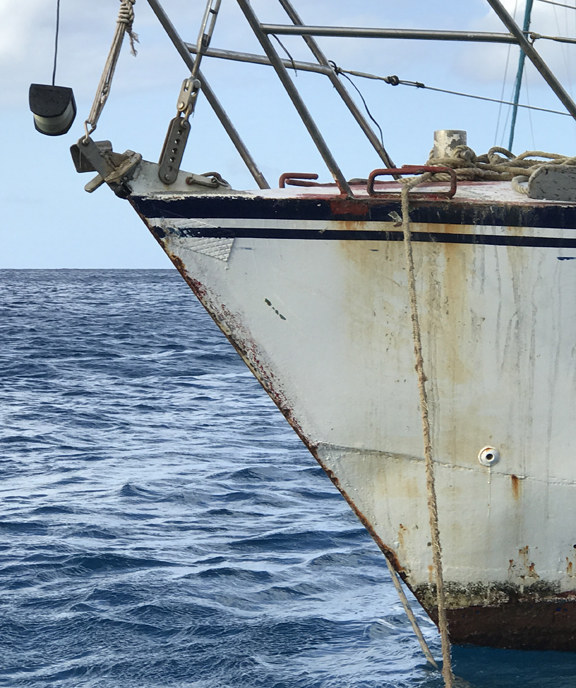
©2017Latitude 38 Media, LLC
All in all, it was a terrible way to end what had been a great night. The Wanderer wanted to put fenders on the port side of ‘ti Profligate, then slowly move forward to raise our anchor and set it elsewhere. It might mean I’d have to slice one of his anchor rodes, but that would be his tough luck.
No fan of bold actions, de Mallorca had a fit at this suggestion and didn’t want any part of it. While the other guy surely didn’t have insurance, I did. Having insurance is hardly the magic elixir, however, if your boat, pulpits and lifelines get smashed up, and you have a $5,000-$10,000 deductible.
In the end, the big hill won out. It seemed to be blocking most of the wind, so the Wanderer agreed to hit the bunk with fingers crossed. The plan was to move the cat first thing in the morning.
The other boat made it through the night without dragging. But the skipper of the other boat was gone to shore at dawn, making moving my cat problematic.
Doña has decided to stay on the boat. “What should I do if the boat drags down on us?” she asked.
“Stay the hell out of the way and don’t get hurt,” I told her.
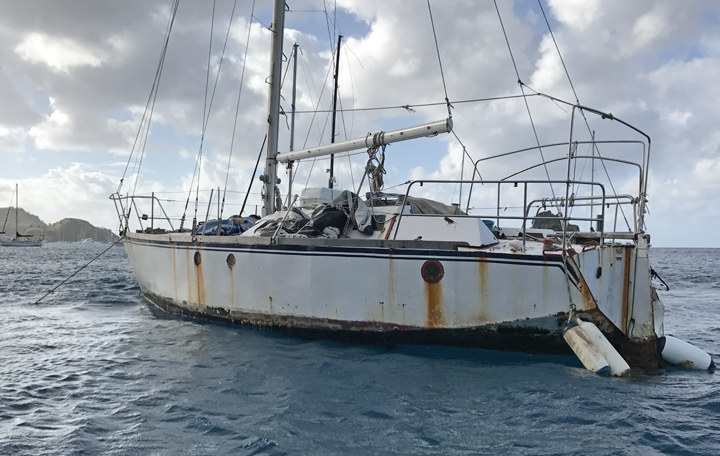
©Latitude 38 Media, LLC
Officials from the port captain’s office came by later on, and de Mallorca explained the situation. They said they knew the guy and the boat, and sympathized with our situation. They said they would put a warning sticker on his boat. We’re not sure that’s going to keep his boat from hitting ours, but that’s as much as they were willing to do.
It’s supposed to blow hard for two more days. We’ll have to see how it goes.
Normally we’d ask if you’ve ever found yourself in a similar situation, but we’re sure you never have.
